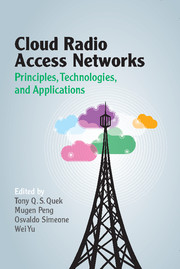Book contents
- Frontmatter
- Contents
- Acknowledgments
- Foreword
- Preface
- List of Contributors
- Part I Architecture of C-RANs
- Part II Physical-Layer Design in C-RANs
- 3 The Tradeoff of Computational Complexity and Achievable Rates in C-RANs
- 4 Cooperative Beamforming and Resource Optimization in C-RANs
- 5 Training Design and Channel Estimation in C-RANs
- 6 Massive MIMO in C-RANs
- 7 Large-Scale Convex Optimization for C-RANs
- 8 Fronthaul Compression in C-RANs
- 9 Adaptive Compression in C-RANs
- Part III Resource Allocation and Networking in C-RANs
- Part IV Networking in C-RANs
- Index
- References
5 - Training Design and Channel Estimation in C-RANs
from Part II - Physical-Layer Design in C-RANs
Published online by Cambridge University Press: 23 February 2017
- Frontmatter
- Contents
- Acknowledgments
- Foreword
- Preface
- List of Contributors
- Part I Architecture of C-RANs
- Part II Physical-Layer Design in C-RANs
- 3 The Tradeoff of Computational Complexity and Achievable Rates in C-RANs
- 4 Cooperative Beamforming and Resource Optimization in C-RANs
- 5 Training Design and Channel Estimation in C-RANs
- 6 Massive MIMO in C-RANs
- 7 Large-Scale Convex Optimization for C-RANs
- 8 Fronthaul Compression in C-RANs
- 9 Adaptive Compression in C-RANs
- Part III Resource Allocation and Networking in C-RANs
- Part IV Networking in C-RANs
- Index
- References
Summary
Background Overview
In the era of mobile Internet, the explosive growth of data traffic imposes a heavy strain on mobile operators to manage networks efficiently while maintaining the quality of service (QoS). It is envisioned that more diverse intelligent mobile devices will be incorporated in the future fifth generation (5G) networks [1].
Cloud-Ran (C-RAN) is a novel RAN architecture, proposed by China Mobile with the aim of achieving the goal of green communication, which has demonstrated its superiority over the conventional cellular networks in terms of energy and spectral efficiencies [2]. Cloud C-RANs are still faced with challenges for successful implementation and commercial operation. One of the major key technical issues awaiting timely resolution in C-RANs is the lack of instantaneous channel state information (CSI), which is essential for beamforming and for coherent reception. As a matter of fact, nearly all the advanced technologies operated in C-RANs demand an accurate knowledge of CSI. The assumption that perfect CSI is known at the baseband unit (BBU) pool is also not practical owing to the time-varying nature of the radio channel. Consequently, developing accurate and reliable channel estimation techniques is vital to support the feasible design of C-RANs.
5.1.1 The Introduction of Channel Estimation
Channel estimation as a fundamental problem in wireless communication systems has been extensively investigated in the past few decades [3]. In general, channel estimation can be basically categorized into two kinds of strategies, i.e., training-based and non-training-based channel estimation. Training-based channel estimation is the most commonly used method owing to its flexibility and low complexity. By periodically inserting the training sequences into data frames in the time or frequency domain, the receiver can easily obtain a reliable estimate of the radio channel impulse responses by means of prior knowledge of the training sequences [4]. However, the use of training sequences will degrade the system performance in terms of the spectral and energy efficiencies, as additional spectrum resource is consumed by the training transmission. Therefore, non-training-based channel estimation is proposed as an alternative way to obtain CSI, by adequately using the intrinsic characteristics of the data signal itself instead of using training [5]. Despite the high spectral efficiency, there still exist many restrictions of non-training-based channel estimation, e.g., a slow convergence speed, high computation complexity and sensitivity to noise, which to some extent limit its implementation.
Information
- Type
- Chapter
- Information
- Cloud Radio Access NetworksPrinciples, Technologies, and Applications, pp. 82 - 116Publisher: Cambridge University PressPrint publication year: 2017
